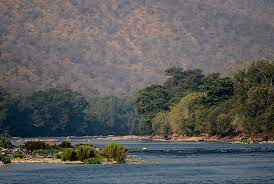Kaveri South Indian River, Know More About It
The Kaveri, also known as Cauvery, is one of the major Indian rivers flowing through the states of Karnataka and Tamil Nadu.
In ancient Tamil literature, it was also called Ponni (the golden maid, about the fine silt it deposits).
The Kaveri river rises at Talakaveri in the Brahmagiri range in the Western Ghats, Kodagu district of Karnataka, at an elevation of 1,341 m above mean sea level and flows for about 800 km before its outfall into the Bay of Bengal.
It reaches the sea in Poompuhar in the Mayiladuthurai district.
It is the third-largest river – after Godavari and Krishna – in southern India and the largest in the State of Tamil Nadu, which, on its course, bisects the state into north and south.
The Kaveri is a sacred river to the people of South India and is worshipped as the Goddess Kaveriamma.
It is considered to be among the seven holy rivers of India.
It is extensively used for agriculture in both of the states mentioned above.

The etymology of the river was derived from the Sankheti word for “river”
The etymology of the river was derived from the Sankheti word for “river”, kaaviri kaaveeri (kaveri), as this is the major river for the Sankethi people live along its waters.
The catchment area of the Kaveri basin is estimated to be 81,155 square kilometers (31,334 sq mi), with many tributaries including Harangi, Hemavati, Kabini, Bhavani, Lakshmana Tirtha, Noyyal, and Arkavati.
The river basin covers three states and a Union Territory as follows: Tamil Nadu, 43,868 square kilometers (16,938 sq mi); Karnataka, 34,273 square kilometers (13,233 sq mi); Kerala, 2,866 square kilometers (1,107 sq mi), and Puducherry, 148 square kilometers (57 sq mi).
In Chamarajanagar district, it forms the island of Shivanasamudra, on either side of which are the scenic Shivanasamudra Falls that descend about 100 meters (330 ft). The river is the source of an extensive irrigation system and for hydroelectric power.
The river has supported irrigated agriculture for centuries and served as the lifeblood of southern India’s ancient kingdoms and modern cities.
Access to the river’s waters has pitted Indian states against each other for decades.
It was profusely described in the Tamil Sangam literature and is held in great reverence in Hinduism.
The Kaveri river delta is thickly populated, one which is frequently affected by tropical cyclones formed in the Bay of Bengal.

Kaveri South Indian River, Know More About It
About Kaveri River water dispute
The sharing of the Kaveri River waters has been the source of a severe conflict between the two Indian states of Tamil Nadu and Karnataka.
The genesis of this conflict rests in two agreements in 1892 and 1924 between the Madras Presidency and the Kingdom of Mysore.
The 802 kilometers (498 mi) Kaveri river has a 44,000 km2 basin area in Tamil Nadu and a 32,000 km2 basin area in Karnataka.
The inflow from Karnataka is 425 TMCft, whereas that from Tamil Nadu is 252 TMCft.
Based on the inflow, Karnataka demands its due share of water from the river.
It states that the pre-independence agreements are invalid and are angled heavily in favor of the Madras Presidency and has demanded a renegotiated settlement based on “equitable sharing of the waters.”
On the other hand, Tamil Nadu says that it has already developed almost 3,000,000 acres (12,000 km2) of land and has come to depend very heavily on the existing pattern of usage.
It says that any change in this pattern will adversely affect the livelihood of millions of farmers in the state.

Kaveri South Indian River
The pre Independence agreement was based on the area occupied by the Mysuru Kingdom and Madras presidency.
The areas of South Canara (previously under Madras presidency), Coorg Province, which was later merged with Karnataka, have not been accounted for to calculate the right of Karnataka’s water share.
Although the River Kavery originated in the Coorg Province, the Coorg province was not included in the agreement.
This raises a question about the validity of bilateral agreements between Mysuru and Madras presidencies.
Decades of negotiations between the parties bore no fruit until the Government of India constituted a tribunal in 1990 to look into the matter.
After hearing arguments of all the parties involved for the next 16 years, the tribunal delivered its final verdict on 5 February 2007.
In its verdict, the tribunal allocated 419 TMC of water annually to Tamil Nadu and 282 TMC to Karnataka; 30 TMC of Cauvery river water to Kerala, and 7 TMC to Puducherry.
Karnataka and Tamil Nadu being the major shareholders, Karnataka was ordered to release 192 TMC of water to Tamil Nadu in a typical year from June to May.
The dispute, however, did not end there, as all four states decided to file review petitions seeking clarifications and possible renegotiation of the order.
Follow us or bookmark us for more Bollywood news box office collection report celebrities trailers and promos
Join us on Facebook
Join us on Twitter



